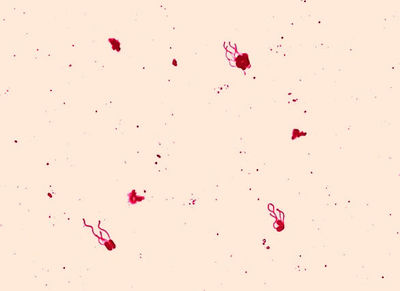Alcaligenes faecalis NEUF2011: Difference between revisions
Burridge.h (talk | contribs) |
Burridge.h (talk | contribs) |
||
| Line 33: | Line 33: | ||
==Genome structure== | ==Genome structure== | ||
[[Image:eyes.jpg|thumb|300px| | [[Image:eyes.jpg|thumb|300px|left|'''Figure 3'''--'''Genes for the arsenite oxidase region in ''A. faecalis'''''<br/> (a) The left eye shows edematous lids, congestion, and exudates in the anterior chamber on second postoperative day. (b) The eye on the eighth postoperative day after intravitreal injection showing reduction of exudates. (c) The eye with posterior capsule opacification at the end of second month. (d) The eye after Nd:Yag opening. Photograph by [http://www.nature.com/eye/journal/v20/n8/fig_tab/6702080f1.html S Kaliaperumal ''et al'' (6).]]] | ||
Revision as of 00:59, 19 October 2011
A Microbial Biorealm page on the genus Alcaligenes faecalis NEUF2011

Leifson flagella stain of Alcaligenes faecalis (digitally colorized). Photograph by Dr. William A. Clark (1).
Classification
Higher order taxa
- Domain: Bacteria
- Phylum: Proteobacteria
- Class: Beta Proteobacteria
- Order: Burkholderiales
- Family: Alcaligenaceae
- Order: Burkholderiales
- Class: Beta Proteobacteria
- Phylum: Proteobacteria
Species
- Genus: Alcaligenes
- Species: faecalis
Alcaligenes faecalis
Description and significance

(a) The left eye shows edematous lids, congestion, and exudates in the anterior chamber on second postoperative day. (b) The eye on the eighth postoperative day after intravitreal injection showing reduction of exudates. (c) The eye with posterior capsule opacification at the end of second month. (d) The eye after Nd:Yag opening. Photograph by S Kaliaperumal et al (6).
Alcaligenes faecalis occur in water and soil. The microbe has peritrichous flagellar arrangement which allows for motility (2). It is a gram-negative, rod-shaped organism observed at 0.5-1.0 μm x 0.5-2.6 μm in diameter. An aerobic microbe, A. faecalis is optimal at temperatures between 20-37 °C (3).
This microbe is most commonly seen in the clinical laboratory. Most infections caused by A. faecalis are opportunistic and acquired from moist items such as nebulizers, respirators, and lavage fluids. When an infection occurs, it is usually in the form of a urinary tract infection (2). However, A. faecalis is also known to be the pathogen that causes bacterial keratitis and postoperative endophthalmitis. Numerous strains have been isolated from clinical material such as blood, urine and feces (3).
As seen in a study on metabolic energy in Alcaligenes faecalis, it was found that the microbe survives in cultures of 10 g/L of aqueous arsenic. The observed thriving of the microbe in arsenic is important in bioremediation of environments contaminated with aqueous arsenic (4). In environments with high arsenic, the community must be wary of the likely presence of A. faecalis and its tendency to cause infections.
Genome structure

(a) The left eye shows edematous lids, congestion, and exudates in the anterior chamber on second postoperative day. (b) The eye on the eighth postoperative day after intravitreal injection showing reduction of exudates. (c) The eye with posterior capsule opacification at the end of second month. (d) The eye after Nd:Yag opening. Photograph by S Kaliaperumal et al (6).
Describe the size and content of the genome. How many chromosomes? Circular or linear? Other interesting features? What is known about its sequence?
Only parts of the Alcaligenes faecalis genome have been sequenced by researchers. The arsenic processing genes have been of
Cell structure and metabolism
As Alcaligenes faecalis is a gram-negative bacterium, it possesses an outer membrane, a thin (compared to gram-positive bacteria) peptidoglycan layer, and a periplasm. These three layers form the gram-negative cell envelope.
Alcaligenes faecalis is unusual among gram-negative bacteria for it's ability to aerobically desaturate saturated fatty acids in order to produce monosaturated fatty acids (3). Higher-order organisms such as animals, protozoa, and various types of algae have this ability, while most bacteria and almost all gram-negative bacteria use an anaerobic pathway. Alcaligenes faecalis has also demonstrated the ability to enzymatically metabolize arsenite (AsO2-, oxidation state +3) to the less harmful arsenate (AsO4-, oxidation state +5). This bacterium could be useful for neutralization of environments contaminated by arsenite.
Ecology
Habitat; symbiosis; contributions to the environment.
Pathology
How does this organism cause disease? Human, animal, plant hosts? Virulence factors, as well as patient symptoms.
Current Research
- Crude biosurfactant from thermophilic Alcaligenes faecalis: Feasibility in petro-spill bioremediation
- Improvement in ammonium removal efficiency in wastewater treatment by mixed culture of Alcaligenes faecalis No. 4 and L1
Interesting Fact
Peritonitis (inflammation of the thin tissue that lines the inner wall of the abdomen and covers most of the abdominal organs) is commonly found in peritoneal dialysis (PD) patients due to contamination of the dialysis catheter. The most common pathogens causing peritonitis in PD patients are gram positive (Staphylococcus epidermidis and Staphylococcus aureus). Recently there have been unusual cases of A. faecalis causing peritonitis in PD patients. A. faecalis is not only a Gram negative bacterium but also an environmental organism. Both of these characteristics are rarely found to cause such significant infections and has since been identified as a pathogen in clinical peritonitis cases.(5)
References
2. Winn, W., Sommers, H., Koneman, E., Janda, W., Dowell, V., and Allen, S. "Color Atlas and Textbook of Diagnostic Microbiology". 'J.B. Lippincott Company'. 1988. Edition 3. p. 184, 200-201.
3. Bharali, P., Das, S., Konwar, B.K., and Thakur, A.J. (2001) Crude biosurfactant from thermophilic Alcaligenes faecalis: Feasibility in petro-spill bioremediation. Internation Biodeterioration & Biodegradation. 65:682-690.
4. Joo, H., Hirai, M., and Shoda, M. (2006) Improvement in ammonia removal efficiency in wastewater treatemnt by mixed culture of Alcaligenes faecalis No. 4 and L1. Journal of Bioscience and Bioengineering. 103(1):66-73.
5. Kahveci, A., Asicioglu, E., Tigen, E., Ari, E., Arikan, H., Odabasi, Z., and Ozener, C. (2011) Unusual causes of peritonitis in a peritoneal dialysis patient: Alcaligenes faecalis and Pantoea agglomerans. Annals of Clinical Microbiology and Antimicrobials. 10:12.
- Created and Edited by Kevin Wieczerza, Stephanie Freed, Amanda McKenzie, Hughes Burridge -- Students of Dr. Iris Keren
